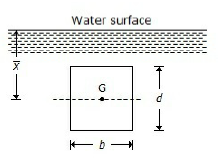Flow of water in a pipe about 3 metres in diameter can be measured by
Orifice plate
Venturimeter
Rotameter
Pitot tube
Correct Answer :
D. Pitot tube
Related Questions
The power absorbed (in watts) in overcoming the viscous resistance of a footstep bearing is
μ π³ N² R² /1800 t
μ π³ N² R⁴ /1800 t
μ π³ N² R² /3600 t
μ π³ N² R⁴ /3600 t
In an internal mouthpiece, the absolute pressure head at vena contracta is __________ the atmospheric pressure head by an amount equal to height of the liquid above the vena contracta.
Less than
More than
Equal to
None of these
A vertically immersed surface is shown in the below figure. The distance of its centre of pressure from the water surface is 
(bd²/12) + x
(d²/12 x) + x
b²/12 + x
d²/12 + x
The ratio of absolute viscosity to mass density is known as
Specific viscosity
Viscosity index
Kinematic viscosity
Coefficient of viscosity
Reynold's number is the ratio of the inertia force to the
Surface tension force
Viscous force
Gravity force
Elastic force
The liquid used in manometers should have
Low density
High density
Low surface tension
High surface tension
When a tube of smaller diameter is dipped in water, the water rises in the tube with an upward __________ surface.
Concave
Convex
Plane
None of these
Euler's equation in the differential form for the motion of liquids is given by
dp/ρ + g.dz + v.dv = 0
dp/ρ - g.dz + v.dv = 0
ρ.dp + g.dz + v.dv = 0
ρ.dp - g.dz + v.dv = 0
A flow in which the volume of a fluid and its density does not change during the flow is called _________ flow.
Incompressible
Compressible
Viscous
None of these
Select the correct statement
Weber's number is the ratio of inertia force to elastic force.
Weber's number is the ratio of gravity force to surface tension force.
Weber's number is the ratio of viscous force to pressure force.
Weber's number is the ratio of inertia force to surface tension force.
The atmospheric pressure with rise in altitude decreases
Linearly
First slowly and then steeply
First steeply and then gradually
Unpredictable
The property of a fluid which enables it to resist tensile stress is known as
Compressibility
Surface tension
Cohesion
Adhesion
Re-entrant or Borda's mouthpiece is an __________ mouthpiece.
Internal
External
Both A and B
None of these
The surface tension of mercury at normal temperature is __________ that of water.
Same as
Lower than
Higher than
None of these
Metacentric height is the distance between the metacentre and
Water surface
Center of pressure
Center of gravity
Center of buoyancy
Fluid is a substance that
Cannot be subjected to shear forces
Always expands until it fills any container
Has the same shear stress at a point regardless of its motion
Cannot remain at rest under action of any shear force
The total pressure on an immersed surface inclined at an angle θ with the liquid surface is
wA
wx
wAx
wAx/sinθ
Water is a __________ fluid.
Real
Ideal
Newtonian
Non-Newtonian
A balloon lifting in air follows the following principle
Law of gravitation
Archimedes principle
Principle of buoyancy
All of the above
Which of the following statement is wrong?
A flow whose streamline is represented by a curve is called two dimensional flow.
The total energy of a liquid particle is the sum of potential energy, kinetic energy and pressure energy.
The length of divergent portion in a Venturimeter is equal to the convergent portion.
A pitot tube is used to measure the velocity of flow at the required point in a pipe.
The pressure in Pascals at a depth of 1 m below the free surface of a body of water will be equal to
1 Pa
91 Pa
981 Pa
9810 Pa
One stoke is equal to
10-2 m2/s
10-3 m2/s
10-4 m2/s
10-6 m2/s
Water is __________ liquid.
A compressible
An incompressible
Both A and B
None of these
In order to measure the flow with a Venturimeter, it is installed in
Horizontal line
Inclined line with flow upwards
Inclined line with flow downwards
Any direction and in any location
The force present in a moving liquid is
Inertia force
Viscous force
Gravity force
All of these
The unit of dynamic viscosity in S.I. units is
N-m/s2
N-s/m2
Poise
Stoke
Bernoulli's equation is applied to
Venturimeter
Orifice meter
Pitot tube
All of these
The body will float if the force of buoyancy is __________ the weight of the liquid displaced.
Equal to
Less than
More than
None of these
Metacentre is the point of intersection of
Vertical upward force through e.g. of body and center line of body
Buoyant force and the center line of body
Midpoint between e.g. and center of buoyancy
All of the above
The total pressure on the surface of a vertical sluice gate 2 m x 1 m with its top 2 m surface being 0.5 m below the water level will be
500 kg
1000 kg
1500 kg
2000 kg
